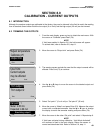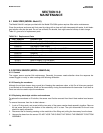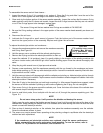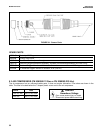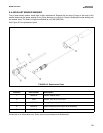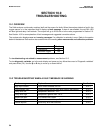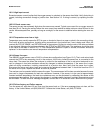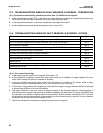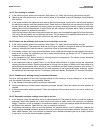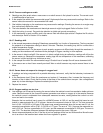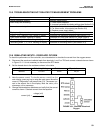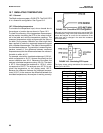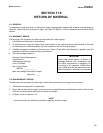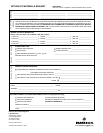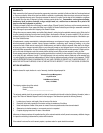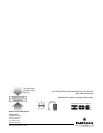
MODEL DO-03/04 SECTION 10.0
TROUBLESHOOTING
10.4.2 Zero reading Is unstable.
A. Is the sensor properly wired to the analyzer? See Section 3.3. Verify that all wiring connections are tight.
B. Readings are often erratic when a new or rebuilt sensor is first placed in service. Readings usually stabilize
after an hour.
C. Is the space between the membrane and cathode filled with electrolyte solution and is the flow path between
the electrolyte reservoir and the membrane clear? Often the flow of electrolyte can be started by simply hold-
ing the sensor with the membrane end pointing down and sharply shaking the sensor a few times as though
shaking down a clinical thermometer. If shaking does not work, perform the checks below. Refer to the sensor
instruction manuals for additional information.
Verify that the holes at the base of the cathode stem are open (use a straightened paperclip to clear the holes).
Also verify that air bubbles are not blocking the holes. Fill the reservoir and establish electrolyte flow to the
cathode. Refer to the sensor instruction manual for the detailed procedure.
10.4.3 Sensor can be calibrated, but current in air is too high or too low
A. Is the sensor properly wired to the analyzer? See Section 3.3. Verify that all connections are tight.
B. Is the membrane dry? The membrane must be dry during air calibration. A droplet of water on the membrane
during air calibration will lower the sensor current and cause an inaccurate calibration.
C. If the sensor current in air is very low and the sensor is new, either the electrolyte flow has stopped or the mem-
brane is torn or loose. For instructions on how to restart electrolyte flow see Section 10.4.2. To replace a torn
membrane, refer to Section 9.2.
D. Is the temperature low? Sensor current is a strong function of temperature. The sensor current decreases
about 3% for every °C drop in temperature.
E. Is the membrane fouled or coated? Slime, oil, and solids inhibit diffusion of oxygen through the membrane,
reducing the sensor current. Clean the membrane by rinsing it with a stream of water from a wash bottle or by
gently wiping the membrane with a soft tissue. Also, increase the air blast cleaning frequency and duration. If
cleaning the membrane and increasing the air blast frequency do not improve the sensor response, replace
the membrane and electrolyte solution. If necessary, polish the cathode. See Section 9.2 for more information.
10.4.4 Possible error warning during in-process calibration
This error warning appears if the current process reading and the reading it is being changed to, ie, the reading
from the standard instrument, are appreciably different.
A. Is the standard instrument properly zeroed and calibrated?
B. Are the standard and process sensor measuring the same sample? Place the sensors as close together as
possible.
C. Is the process sensor working properly? Check the response of the process sensor in air and in sodium sul-
fite solution.
10.4.5 Barometric pressure reading is too high or too low.
A. Is the pressure inside the enclosure equal to ambient pressure? The pressure sensor is inside the analyzer
enclosure. When cable glands are in place and the front panel is tightly closed, the enclosure is moderately
airtight. Therefore, as the air trapped in the enclosure heats or cools, the pressure inside the enclosure may
be different from ambient. Open the front door to equalize the pressure.
B. If equalizing the pressure does not solve the problem, the pressure sensor is out of calibration. Calibrate the
sensor against the local barometric pressure. Be sure to use the actual barometric pressure. Pressure, some-
times called altimeter, from a local airport or pressure from a weather forecasting service is usually corrected
to sea level. It is not the actual barometric pressure.
57



